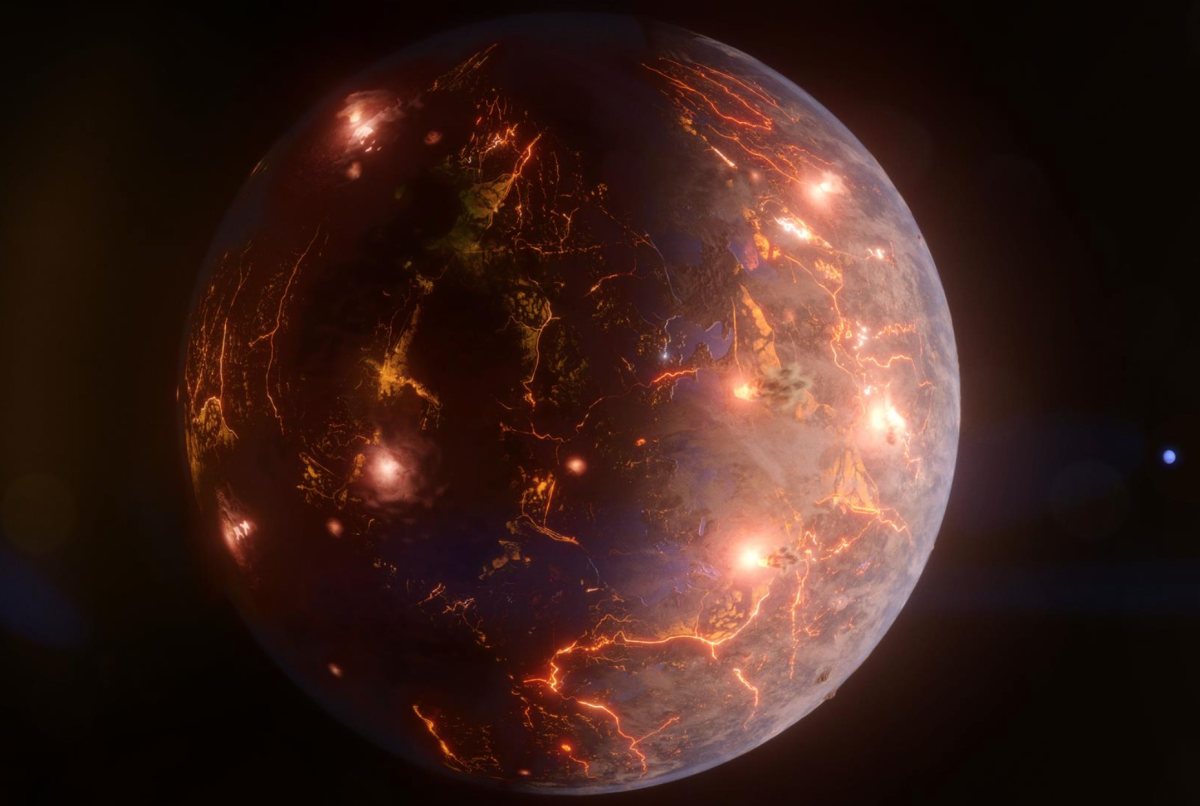An exoplanet the size of Earth has been discovered in a distant solar system, and it could be bursting with volcanic activity.
According to a paper published on Wednesday in the journal Nature, the planet, named LP 791-18 d, could possibly be as explosive as Jupiter's moon Io—the most volcanically active body in our solar system.
The potential existence of volcanoes on the planet, combined with the possible presence of liquid water, could provide the conditions for the evolution of life, scientists said. It could also offer new insights into how Earth formed.
LP 791-18 d is the third planet found in its solar system, after its neighbors LP 791-18 b and LP 791-18 c were discovered in 2019, and is thought to be volcanic by scientists.

Exoplanets are planets orbiting other stars, far from our own solar system. As of May 1, 5,381 exoplanets have been found, spread across 3,974 planetary systems. Of these solar systems, 858 of them are multi-planet systems.
LP 791-18 d is one such exoplanet, and orbits a dim, red dwarf star around 86 light-years away from our solar system, and is roughly the same size as our home planet.
Due to its immense distance from Earth, scientists did not directly observe LP 791-18 d's volcanism. Rather, they inferred it based on the planet's interactions with its neighboring planets.
LP 791-18 d orbits between LP 791-18 b, which is around 20 percent bigger than Earth, and LP 791-18 c, roughly 250 percent larger than Earth.
The researchers concluded that the gravitational pull from the larger neighboring planets may squeeze and shift LP 791-18 d like a stress ball, causing its interior to heat up through friction. This is why Jupiter's moon Io is so volcanic: the gravity of Jupiter and its other moons cause enough flexing to create geothermal activity within the moon.

LP 791-18 d is situated on the inner edge of its star's "Goldilocks zone," meaning that liquid water could exist on its surface. The zone refers to the habitable region around a star where the temperature allows liquid water to exist on a body's exterior.
"LP 791-18 d is tidally locked, which means the same side constantly faces its star," said Björn Benneke in a NASA statement. Benneke is a co-author of the published paper and an astronomy professor at iREx, which planned and supervised the study. iRex is the Trottier Institute for Research on Exoplanets at Montreal University in Canada.
"The day side would probably be too hot for liquid water to exist on the surface. But the amount of volcanic activity we suspect occurs all over the planet could sustain an atmosphere, which may allow water to condense on the night side," Benneke said.
The potential presence of liquid water, combined with its potential volcanism, may mean that the planet is a more likely candidate for the evolution of life than other, drier worlds.
"A big question in astrobiology, the field that broadly studies the origins of life on Earth and beyond, is if tectonic or volcanic activity is necessary for life," said Jessie Christiansen, a co-author of the paper. Christiansen is a research scientist at NASA's Exoplanet Science Institute at the California Institute of Technology in Pasadena.
"In addition to potentially providing an atmosphere, these processes could churn up materials that would otherwise sink down and get trapped in the crust, including those we think are important for life, like carbon."
Discovery Alert!📣
— NASA Exoplanets (@NASAExoplanets) May 17, 2023
An Earth-sized world on the edge of its habitable zone is being pulled by a super-Earth with such force that scientists think it's causing volcanic activity. And those volcanoes might mean nightside clouds (and maybe water?). https://t.co/XgBSXHFa6u pic.twitter.com/FIhkI6KWpb
The authors hope that studying this planet will also help us to understand how our own planet formed.
Newsweek has reached out to NASA via email for comment.
The James Webb Space Telescope—the largest optical telescope currently in space—may help astronomers gain a large amount of detail about the exoplanets they study, such as the presence of certain chemicals in the planet's atmosphere.
"With James Webb, you open up the amount of colors and regions; and colors equates to what kind of molecules you can detect," Néstor Espinoza previously told Newsweek. Espinoza is an astrophysicist and astronomer at the Space Telescope Science Institute in Baltimore, Maryland.
"It's a game-changer in the precision, because the telescope is so large and so stable," he said. "The fact that we can not only explore this, but explore it very precisely, is something that we have not accessed before."
Using these signatures, the James Webb is hoped to further the search for extra-terrestrial life.
"Now in terms of the prospects of the James Webb Space Telescope detecting life, I don't think it's very likely, to be very honest," Espinoza said. "And I'm a good scientist, I'm putting [up] the 'not-very-likely' warning. Because we don't know what we're going to be seeing in these data.
"But it will be good to keep in mind that the answer, I think, that the James Webb Space Telescope can really answer is: 'Does this planet have an atmosphere at all or not?' That's the very big question. That is one that is key. And it's like a small step for our students, but a huge step for mankind," he said.
Do you have a tip on a science story that Newsweek should be covering? Do you have a question about exoplanets? Let us know via science@newsweek.com.
Uncommon Knowledge
Newsweek is committed to challenging conventional wisdom and finding connections in the search for common ground.
Newsweek is committed to challenging conventional wisdom and finding connections in the search for common ground.
About the writer
Jess Thomson is a Newsweek Science Reporter based in London UK. Her focus is reporting on science, technology and healthcare. ... Read more





